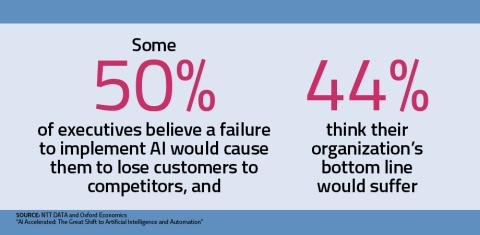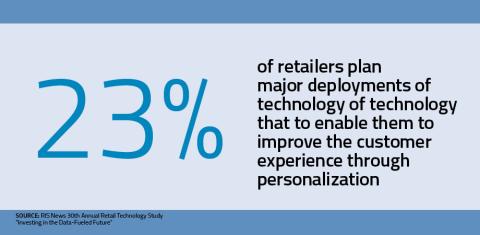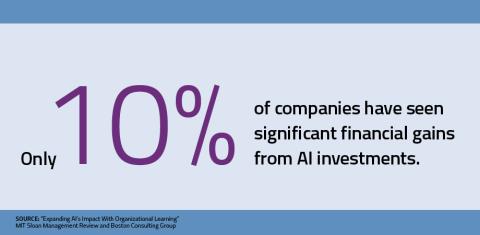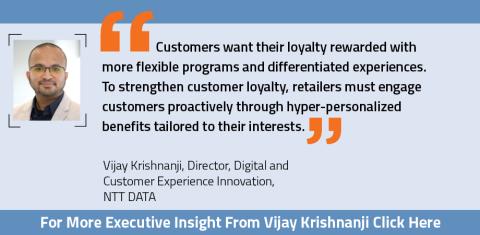Harnessing the Transformative Power of Data Analytics and Artificial Intelligence In Retail
Lines of cars parked in front of stores, filled with customers waiting in their vehicles for items they have purchased online. Consumers taking their business from one store to another in search of a better, more personalized shopping experience, faster delivery, or the satisfaction of finding the items they want without driving from location to location. Retailers scratching their heads ever harder about how to stock their shelves, grappling with product shortages, and fighting competition from their market as well as from other market segments.
There are no two ways about it: While the retail industry has always been in a state of change, the pace of change is picking up dramatically. Consider just a few numbers:
- 92% of retailers say customers expect a personalized experience, up from 85% last year.
- 86% of consumers are willing to pay more for a better customer experience.
- 71% of consumers are receiving items through local delivery more frequently than before the pandemic began, while 69% of consumers utilize “buy online, pick up in-store” (BOPIS).
- 67% of US millennials are likely to purchase products and services from brands using a chatbot.
- 47% of shoppers are (now) open to purchasing items through a bot.
Consumers are becoming increasingly demanding — they expect a higher caliber of customer service, personalized assistance, immediate or near-immediate access to merchandise, and a hassle-free experience whether shopping in-store or online. They are also more insistent on beginning their shopping journey online and complete it in-store, or vice versa — as well as on faster home delivery. A larger-than-ever number of consumers, even older consumers, have transitioned to purchasing all or most of their groceries online; many will continue to do so going forward. In all shopping endeavors, it is all about quick, safe, and easy.
At the same time, competitive pressure from within and outside the retail sector is driving retailers to explore and adopt new business and operational models — for example, introducing new digital marketplace and direct-to-consumer models, redesigning healthcare delivery, and enhancing last-mile fulfillment options, such as BOPIS. Change is also occurring on the employee side as associates are tasked with additional responsibilities, such as filling online orders or clienteling in an already-packed day, to meet evolving customer expectations.
Not surprisingly, the COVID-19 pandemic and its anticipated aftermath have complicated — and continue to complicate — this picture. Consumers have faced product shortages and difficulty finding order delivery windows. COVID-19-related concerns also mean elevated customer experience requirements — consumers aim to minimize browsing time, to avoid going to multiple stores to find the items they need, or to shop primarily online. The end-result: marked consumer interest in — and retailers’ initiatives to deliver — high-caliber combined physical and digital (“phygital”) experiences.
The pandemic has also created havoc for already-strained supply chains, disrupting international supply routes and creating unprecedented demand for certain merchandise, among other challenges. Asked to list the top five supply chain obstacles that reduce their supply chain efficiency and productivity, 73% of retailers queried for RIS News’ “Supply Chain Technology Study 2020” cited an ability to adjust or respond to fluctuations in demand, while 71% pointed to a lack of real-time inventory visibility; 56%, to an inability to make rapid adjustments with supply chain partners; and 56%, to “inventory sources stretched too far.”
These collective forces necessitate digital transformation by retailers at a pace faster than ever before. Read on and discover how the key components of this transformation — data, analytics and automated technology tools powered by an artificial intelligence (AI) engine that leverages algorithms to mimic human processes, drawing conclusions from data — can help set retailers apart.
The Value Proposition
Data, analytics, and AI offer retailers a multifaceted value proposition, allowing them to better understand customers, individualize customer experiences, and effectively engage customers in an omnichannel manner. Through data, analytics, and AI, retailers can also automate critical operations and supply chain processes and obtain support for human decisions that pertain to both areas. Overall, these technologies give retailers the power to adapt and adjust to industry-wide changes — and to the pace at which these changes are occurring.
Unquestionably, retailers already perceive AI as a game-changer. Some 50% of respondents to a survey by NTT DATA and Oxford Economics (including retail executives) believe a failure to implement AI would cause them to lose customers to competitors, and 44% think their organization’s bottom line would suffer. Similarly, 23% of participants in RIS News’ 30th Annual Retail Technology Study plan “major deployments” of technology — including AI-powered technology — that will enable them to improve the customer experience through personalization. These deployments, respondents said, represent “the single-greatest investment point on the digital front over the next year.”
Strong evidence of AI’s business value — for example, as a catalyst for increased revenues — is emerging as well. Notably, 79% of companies queried for McKinsey & Company’s “2020 Global Survey on AI” reported that AI had bolstered their sales and marketing revenues over the past year. Sixty-five percent pointed to increased revenues stemming from product and service developments supported by AI.
“AI is starting to deliver on its potential, and its benefits for business are becoming a reality,” writes Svetlana Sicular, vice president, analytics, Gartner Hype Cycle, in a recent “Smarter With Gartner” blog. Sicular adds that despite the global impact of Covid-19, 47% of companies surveyed by the firm had not pulled back on their investments in AI and 30% intend to bolster their AI investments going forward.
But while retailers clearly must maximize their investments in AI and related technology, there appear to be challenges. A mere 10% of companies queried for a study by MIT Sloan Management Review and the Boston Consulting Group reported significant financial gains from investments in AI. For retailers, reversing the tide will entail applying data, analytics, and AI to drive improvement and support change at every point in the value chain. It will necessitate functioning as an intelligent enterprise, continuously enhancing and aggregating business intelligence with the goal of building a self-driving business, as well as applying business intelligence in tandem with, rather than instead of, human decision-making.
Enhancing the Omnichannel Customer Experience
Retailers need to reinvent themselves by staying focused on the customer, embracing analytics, AI, and automation while using real-time, accurate data as the bedrock for real-time or near real-time experiences that are personalized, flexible and business-value oriented. This is the new normal. The key difference between analytics used this way and traditional analytics harnessed by retailers in the past is the vast volume of data that can now be captured through IoT technologies in-store and linked to data from the entire customer journey to then “predict” behavior, making the shopping experience quick, safe, and easy for customers and, in turn, driving loyalty and retailer-customer relationships.
The starting point is the use of data analytics and AI to better understand their customers by collecting information, analyzing it, and determining what the next actions should be — for example, which items to promote or what product is best suited for a customer in line with information the customer provided. 1-800-FLOWERS and The North Face, for example, use AI to recommend specific products — 1-800-FLOWERS also depends on AI to determine delivery options for online shoppers. Online thrift store ThredUp utilizes an AI algorithm to track and remember individual customers’ preferences and build “Goody Boxes” of clothing that mirror these preferences.
For its part, Amazon leverages its AI-powered recommendation engine to not only show consumers items they are most likely to buy based on their onsite behavior, but also to reveal items they would likely not have found on their own. Amazon reportedly garners nearly 35% of its sales from personalized recommendations, with 56% of customers likely to engage in repeat buying as a result.
Perhaps more importantly, AI is the enabler of hyper-personalization. It is a “must-do” not only for supporting the highest caliber of customer service, but for fostering revenue growth and improving low margins via suggestive selling, upselling, and cross-selling. Such hyper-personalization is executed through:
- Real-time customer journey orchestration — unified management of vital customer communication touchpoints and tailoring individual journeys for every customer based on that customer’s previous behavior and preferences. Real-time insight is used to anticipate individual needs, and the journey is adjusted along the way to meet new behaviors that occur and new journeys that are expressed. Weis Markets now uses real-time journey orchestration to interact with customers throughout their entire shopping journey via mobile, web, e-mail, or text, delivering up-to-the-minute recommendations based on customer behavior and location.
- Virtual assistants/agents and bots that guide customers through the shopping process and create an engaging, interactive experience. Lidl, for example, has introduced a “wine bot” named Margot that offers recommendations on food and wine pairings as customers shop its grocery aisles. Certain bots and virtual assistants provide nutritional information and other critical product data to consumers. Some retailers are taking this concept further in what must be considered the next evolution of chatbots. For example, Macy’s app now has a wayfinding feature — a chatbot that is programmed to guide shoppers to specific items and inform them whether their desired merchandise is in stock. The chatbot also uses AI to identify instances where a customer requires further help from a store associate and alerts an employee accordingly. Kroger has a bot that customers can use to obtain suggestions of recipes they can prepare based on in-store ingredient availability. Lululemon’s fitting rooms are equipped with technology that allows them to virtually “try on” apparel and guides them through the selection process. In some stores the retailer is also implementing The Mirror, a virtual interactive fitness solution consumer can use at home.
- Digital humans — NTT DATA’s Digital Human solution blends speech-based, natural language interactions with a lifelike avatar. The avatar has the business knowledge to add value to the customer experience and conveys verbal and non-verbal signals to create better “conversations.”
In fulfilling its key role in understanding consumer behavior, analytics deliver scale to in-store analysis of consumer shopping patterns, leading to improved customer experience. Analytics yield insight into what customers want and what is being purchased, by whom. It can also be used to determine delivery preferences and make changes if identified — for instance, offering minute-by-minute updates to customers who want them and less detailed delivery information to those who do not. This leads to improved customer service and makes it easier for retailers to forge emotional connections with consumers.
In a related vein, AI algorithms can be implemented to execute more accurate, targeted marketing campaigns, using ads based on specific customer demographics and purchase behaviors and preferences. Again, this opens doors to new revenue-generating opportunities and minimizes spending on ineffective promotional vehicles. Loblaw’s has hired AI, machine-learning, and data science experts to find ways to harness data pertaining to its more than 18 million PC Optimum loyalty program customers to tailor promotions and create digital “flyers” that promote personalized offers based on past purchases.
Finally, AI is, in certain cases, being used to “bring the entire store to the customer.” Here, a combination of extended reality (XR) and AI technologies lets consumers bring the entire “store” home with them. Lowe’s Measured app, for example, lets consumers measure furniture, rooms, and other items using images and see how they will look in a home setting.
CREATING A BETTER EMPLOYEE EXPERIENCE
It goes without saying, however, that employees are the backbone of the customer experience — and no matter the extent of AI-powered initiatives on the customer side, retailers would be unable to maximize their investment in these initiatives without creating a better experience for team members through empowerment. Empowered frontline employees who are knowledgeable about the products and services the retailer provides, as well as intimately familiar with the needs of each shopper, help to create satisfied and loyal consumers. Such employees also reflect positively on retailers’ brands and serve as brand ambassadors. In a pandemically impacted world where retailers are forced to do more with less, employee empowerment with technology is an imperative to reduce employees’ stress as well as to keep them happy and motivated.
Among the top retail store associate stressors is a consistent lack of sufficient time to complete tasks within the span of a workday. Analysis of store inventory and in-stock data, combined with stores’ point-of-sale and online order data, assists employees by supplying them with optimized picking directives to fill online orders. AI-based task management solutions, meanwhile, help associates keep track of and prioritize tasks, improving productivity and worker satisfaction. The clutter and stress of viewing multiple dashboards or applications to prioritize tasks is simplified and made hassle-free with the help of prescriptive analytics, with store associates using a combination of analytics and human logic — rather than analytics alone — to get the job done.
Improving the employee experience as well are smart scheduling systems that depend on AI to identify and analyze time-and-attendance and store traffic trends, ensuring that stores are sufficiently staffed. These systems consider employee preferences as part of their scheduling “criteria,” generating worker-friendly schedules.
Additionally, for frontline employees who are tasked with clienteling, tools such as recommendation engines that utilize AI to analyze customer data and generate accurate, individualized customer profiles comprise an excellent “value-add.” Further, behind the scenes, retailers can equip remote workers (whether always remote or working from home because of the pandemic) with AI-based tools to facilitate decision-making, handling customer queries, and other tasks. Amazon has jumped on this bandwagon with its “Hands Off the Wheel” initiative, a program aimed at using machine learning and AI to automate processes, free up human resources for more important initiatives, and “do more with the people on staff, rather than doing the same with fewer people,” according to the Harvard Business Review.
IMPROVING STORE AND SUPPLY CHAIN OPERATIONS
Store, warehouse, and supply chain operations is yet another area that stands to benefit from AI, allowing retailers to be proactive, rather than reactive, on all counts. This is of utmost importance: While it is all well and good for retailers to monitor the movement of merchandise in-store, a higher level of efficiency is warranted given the myriad of changes occurring in the customer demand realm and throughout the retail ecosystem. That level of efficiency depends on prediction—for example, of imminent out-of-stocks and low-stock situations — as well as matching inventory levels and availability with real-time buyer trends and supply.
Indeed, data is the driver to make more adjusted decisions about what happens in the physical store. With AI-powered tools and analytics in place, retailers can manage inventory in a smarter fashion. For example, employees or managers can receive alerts when stock in storage or on the shelves is low. These alerts, sent in ample time to address the situation, improve the availability and findability of merchandise while increasing customer satisfaction and reducing lost sales.
Similarly, planogram compliance can be monitored with AI-enabled computer vision or other IoT technologies. Retailers can then make adjustments when high-performing products are out of stock on the shelves, but available elsewhere in the store or from nearby stores through a store-to-store merchandise transfer. When this data is combined with POS data and in-store customer foot traffic, retailers can satisfy the interests and needs of customers while optimizing available space.
Additionally, AI can dictate — based on identified customer purchasing patterns and mitigating factors — the best means of proactively optimizing assortments in-store and driving assortment productivity, whether seasonally, by time of day, in accordance with weather conditions, to match promotions, and the like. It can facilitate more accurate demand forecasting, reducing the risk of shortages and disgruntled customers, and pave the way for dynamic pricing based on market demand.
In the warehouse and on the supply chain front, analytics allows retailers to see, for instance, where (at which stores) and when demand for product will occur or is occurring. This gives them the opportunity to arrange — again proactively — for merchandise to be routed to stores appropriately, in time to meet demand. AI can be leveraged to assess digital twins — virtual “copies” of warehouses — to conduct “what-if” scenarios and perform other analyses pertaining to logistics.
AI also serves as a vehicle for retailers to more easily grapple with demand by identifying local inventory sources, finding sources in low-risk areas (as was necessary, for example, during the height of the COVID-19 pandemic, when sourcing inventory from China became an untenable option), and reducing time to onboard suppliers.
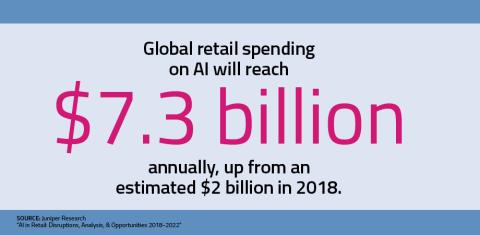
Then, there is the ability of AI to improve operations when it comes to last-mile delivery. Instacart, for example, uses AI to optimize delivery routes, in turn satisfying heightened customer demand for rapid delivery, decreasing the wait for orders to appear at consumers’ doors, and creating a better customer experience. The company also harnesses AI to direct its shoppers’ path through stores as they pick up orders and suggest replacements for out-of-stock items, saving additional time and bolstering customer satisfaction.
Finally, AI facilitates retailers’ adoption of converging market segments — e.g., retail, healthcare, and fintech — that is transforming industries and businesses. For instance, retail players like CVS and Walgreens are moving into the healthcare arena and harnessing AI to offer low-cost, standardized services, such as prescription management, to differentiate themselves from Amazon. Grocery retailers can and should look to handle the transition in part by leveraging churn models, “next-best action,” and cognitive personal assistants to recommend products and services across verticals — e.g., grocery, pharmacy, financial, and telecommunications — to drive more revenue and retain customers.
CONCLUSION: THE AI IMPERATIVE
The journey ahead will continue to bring more seismic shifts for the retail industry, with challenges predicated on changing customer expectations; growing complexity stemming from heightened competition; the convergence of industries, omnichannel operations, and supply chain; data fragmentation across systems and business units; and evolving technology. All of this creates a need to adapt and pivot accordingly. In so doing, retailers must seek management sponsorship; start with a specific use case that addresses a single problem or question and test the application before proceeding to the next step; and ensure that the data to be used is plentiful, highly accurate, and unbiased — among other steps.
Data, analytics, and AI will remain among retailers’ most potent weapons for grappling with such change. Those that fail to move forward with AI face a grave risk of losing out to the competition or failure to meet customer expectations, while those that embrace it will almost certainly emerge ever stronger for their efforts.
AI presents one of the greatest leadership challenges of our times, and the true transformation will need to start from the top.
Hear from the experts at Oxford Economics and NTT DATA to learn how your industry peers are approaching AI. View webinar.
Editor’s Note: This is the third edition in a series of white papers focused on the application of data and data analytics to support and foster retail success in the short and long terms alike. Click here to learn how data can be used to enhance the customer experience and here to discover how and why data is the new frontier for frontline retail workers.


